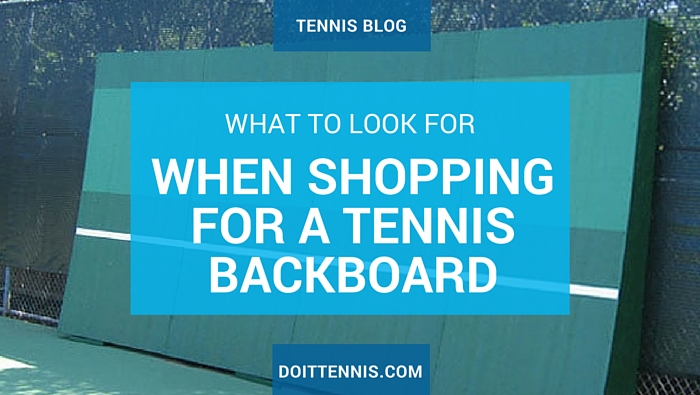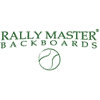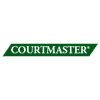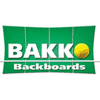What to Look for When Shopping for a Tennis Backboard
August 8th, 2012

Tennis backboards provide great practice opportunities for people without access to a full court or a partner to return their shots. You may be wondering why a backboard would be needed when any simple flat surface would suffice, but the backboards being created have advantages like sloping as well as more sturdy materials to keep the surface from getting warped or chipped.
In this article, I will discuss the materials you should look for in a tennis backboard, the different types of sloping, the manufacturers that can make them, as well as some things to look out for if you are thinking about purchasing one.
Materials
Old backboards were often made of wood or brick, which is more likely to warp with excessive moisture or heat. These materials can also chip away after extended use, causing a normally hit ball to angle off drastically in worn out spots. Current backboards are constructed of fiberglass, which is often coated with UV protected paint. That way, heavy rains just slide right off and the sun is less likely to make the backboard fade in color or become dried out and cracked. Another advantage of this construction is a quieter sound on ball contact, so for those of you tired of that repetitive banging against the garage, this would be a simple solution.
Manufacturers
The three main manufacturers for tennis backboards are Rallymaster, Courtmaster, and Bakko.
 The Rallymaster backboards are all 10 feet high, which is the normal height for a fence, which is recommended for the wall to be up against. You can get a width of 12, 16, 20, 24, 28, or 32 feet across, so however much court you want to cover, you’ll be able to do it. The Rallymaster backboards also come available with a 15 degree tilt upwards, giving the ball more rise on its return, making it easier to rally and keeping the ball from rolling on the ground in its return. For a 10’ x 12’ flat wall, it will cost you around $3,100, and for an angled wall of the same dimensions, about $3,800. One special thing about the Rallymaster boards is that they are covered under warranty for all sports; soccer, lacrosse, and basketball among others are tested on this wall, meaning it is durable and multifunctional.
The Rallymaster backboards are all 10 feet high, which is the normal height for a fence, which is recommended for the wall to be up against. You can get a width of 12, 16, 20, 24, 28, or 32 feet across, so however much court you want to cover, you’ll be able to do it. The Rallymaster backboards also come available with a 15 degree tilt upwards, giving the ball more rise on its return, making it easier to rally and keeping the ball from rolling on the ground in its return. For a 10’ x 12’ flat wall, it will cost you around $3,100, and for an angled wall of the same dimensions, about $3,800. One special thing about the Rallymaster boards is that they are covered under warranty for all sports; soccer, lacrosse, and basketball among others are tested on this wall, meaning it is durable and multifunctional.
 Next is the Courtmaster with their REAListic line of straight-tilt and dual-curved backboards. The straight tilt is a very economical option, with an 8’ x 8’ model running just over $1,000. This version features the excellent construction and noise reducing qualities that Courtmaster provides, and has a tilt that features a similar effect to the Rallymaster tilt backboards. There is also a dual curved version of the Courtmaster REAListic backboard that provides an arc the whole way around, so whether you hit it high, low or in the middle, the shot coming back resembles one you would receive from an opponent on a normal court. It also features small arcs on the side, so wayward balls find their way towards the center, keeping the rally going for extra practice and less time chasing balls. These are available for $1,300 for an 8’ x 8’ model. All Courtmaster models are 8’ high, but you can get a width of 8, 12, or 16 feet across.
Next is the Courtmaster with their REAListic line of straight-tilt and dual-curved backboards. The straight tilt is a very economical option, with an 8’ x 8’ model running just over $1,000. This version features the excellent construction and noise reducing qualities that Courtmaster provides, and has a tilt that features a similar effect to the Rallymaster tilt backboards. There is also a dual curved version of the Courtmaster REAListic backboard that provides an arc the whole way around, so whether you hit it high, low or in the middle, the shot coming back resembles one you would receive from an opponent on a normal court. It also features small arcs on the side, so wayward balls find their way towards the center, keeping the rally going for extra practice and less time chasing balls. These are available for $1,300 for an 8’ x 8’ model. All Courtmaster models are 8’ high, but you can get a width of 8, 12, or 16 feet across.
 Finally, the Bakko lines of backboards are known for being high quality, and if money is not an issue, this is the ultimate player’s backboard. The Bakko backboards come available in either economy flat, professional flat, single curve, or slimline flat. The economy flat is designed to compete with wood backboards and lacks an interior metal frame, whereas the professional flat contains a metal frame and the best construction materials for a long lasting, sound deafening, professional style backboard. The single curve series offers a concave design to raise the ball on low shots as well as lower the ball on high shots. The trajectory is made to resemble playing an actual opponent, so this is going to be the best model for match experience. The final model is the slimline, which is only 1 ¾” thick, making it easy to install and compact enough to fit on any fence. It lacks the sound deadening technology though, so this model is better for a public park or school. You can get a Bakko economy flat backboard for around $1,500 (8’ x 12’). A single curve model (10’ x 12’) will run about $3,000, and all of these backboards come with warranties and quality guarantees.
Finally, the Bakko lines of backboards are known for being high quality, and if money is not an issue, this is the ultimate player’s backboard. The Bakko backboards come available in either economy flat, professional flat, single curve, or slimline flat. The economy flat is designed to compete with wood backboards and lacks an interior metal frame, whereas the professional flat contains a metal frame and the best construction materials for a long lasting, sound deafening, professional style backboard. The single curve series offers a concave design to raise the ball on low shots as well as lower the ball on high shots. The trajectory is made to resemble playing an actual opponent, so this is going to be the best model for match experience. The final model is the slimline, which is only 1 ¾” thick, making it easy to install and compact enough to fit on any fence. It lacks the sound deadening technology though, so this model is better for a public park or school. You can get a Bakko economy flat backboard for around $1,500 (8’ x 12’). A single curve model (10’ x 12’) will run about $3,000, and all of these backboards come with warranties and quality guarantees.
When ordering a backboard, there are a few things to keep in mind.
First, these are very heavy items, and often come delivered as separate panels rather than as a single board. Shipping can cost around $500 or more depending on the size and how far it has to travel. Many delivery companies will only drop the materials off curbside, so make sure you have extra help (multiple people recommended) to transport and install them.
Second, make sure that your fence can support the height of the backboard, because the more support the board has, the better chance it will not be knocked down by high winds/rain. These boards are all constructed for the outdoors, but the elements can cause an extra effect on the wear of the boards. Living somewhere like Hawaii or Florida, the salt in the air can cause oxidation, or if left in an area that is exposed to sunlight, the paint can wear down or chip. Just be sure to factor in these things when ordering a backboard, and I would highly recommend speaking to an expert before ordering your first one.
Hopefully this information helps you on your way to finding a practice partner that will never call in sick or get distracted, which I can guarantee you won't ever hear from any one of these tennis backboards.
If you enjoyed this article, here are some others you may enjoy...


